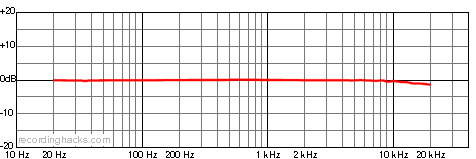 Avenson Audio STO-2
Avenson Audio STO-2
Omnidirectional Condenser Microphone
The STO-2 is a small diaphragm condenser with an omnidirectional pickup pattern, sold in matched pairs for use in stereo miking applications.
The microphones are remarkable for their flat frequency response; published graphs show less than 0.5dB variation from 20Hz–12kHz, and only 1dB of high-frequency rolloff at 20kHz.
As a result, the microphones are among the most honest microphones on the market, with no built-in equalization intended to enhance or flatter a signal.
Based on a pure pressure omnidirectional capsule, the STO-2 exhibits no proximity effect when used close to a sound source. This is useful for close-miking sources that would not benefit from low-frequency buildup, such as wood-bodied acoustic instruments. The STO-2 microphones can be used much closer to such an instrument than could a directional microphone.
This mic started life with a TapeOp article by Joel Cameron called “How to Build a Microphone.” Over months of experiments, revisions, and improvements, Erik Wofford and Brad Avenson elaborated the original concept kit, powered by a 9V battery, into a professional-grade microphone, the STO-2.
Early versions of Wofford and Avenson’s mic were called “Stapes Omnis,” and you’ll find references to these in audio forums and rec.audio.pro. The ‘STO’ in the STO-2 model number stands for STapes Omni; the ‘2’ indicates additional improvements by Brad Avenson.
The Cameron article called for an inexpensive electret omni capsule from Panasonic, the WM-66AY, although apparently this was a typo — the correct part number is WM-60AY. This capsule has since been discontinued, but the WM-61A and WM-61B are reported1, 2 to be comparable.
The same capsule powers T.H.E.’s highly regarded KP-6M Reference microphone, some of Earthworks’ mics, and the inexpensive Behringer ECM80001.
Eric Wofford
Yes, we use the same Panasonic capsules that Earthworks use in their microphones. The difference between ours and the Behringer mics, or just straight out of the box is quite substantial. We modify the capsule so that the FET is rebiased, allowing for a balanced signal, and a drastic increase in SPL limit from the Behringer. The mics are now phantom powered, which is not an easy circuit to build on a board the size of your thumbnail, and the noise is nowhere near as bad as the Behringer mic.
See this TapeOp thread for numerous praiseworthy comments about the Stapes mics.
The STO-2 microphone body is machined out of solid aluminum. The pairs of microphones ship with plastic mic clips in a padded, velvet-lined, engraved wooden storage box.
The Avenson Audio STO-2 is also known as: Stapes Omni, STO2, STO.
Specifications
| Frequency Response - OmnidirectionalClick Graph to Compare! |
|---|
 |
| Pickup Patterns | Pads & Filters |
|---|---|
|
Omnidirectional
(5.25 mV/Pa; 20 - 20,000 Hz) |
|
| Capsule Dimensions | Impedance | SPL/Noise |
|---|---|---|
| Diaphragm diameter: 6mm |
20 Ohms (Low) | Max SPL: 145 dB Self-noise: 28.0 dB(A) |
| Weight | Length | Max Diameter | Interface(s) |
|---|---|---|---|
| 100g (3.53oz) | 127mm (5.00'') | 25mm (0.98'') |
|
| Power Specifications |
|---|
|
Did we get anything wrong on this page? Please let us know!




